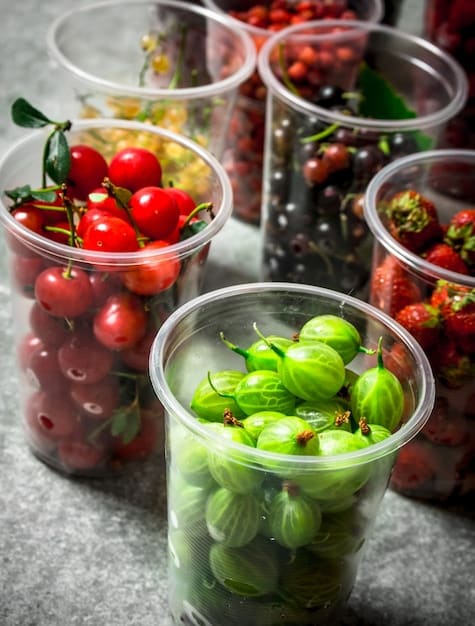Don’t Fall for These Grocery Store Tricks: Avoid Spending Traps

Navigating the supermarket can be a minefield for your budget, as stores employ sophisticated psychological and merchandising tactics designed to encourage impulse buys and inflate your bill, making it crucial for consumers to understand and counter these common spending traps to save money effectively.
Stepping into a grocery store often feels like a straightforward transaction, a simple task of acquiring necessities. Yet, beneath the veneer of neatly stacked produce and inviting aromas, lies a meticulously crafted environment designed to influence your purchasing decisions. Many consumers unwittingly fall prey to subtle, yet highly effective, tactics deployed by supermarkets, leading to larger-than-intended bills and unnecessary spending. Understanding how to navigate this landscape is key to mastering your budget and ensuring you get true value for your money, making it essential to learn how to actively resist these common grocery store tricks: how to avoid common spending traps.
The Psychology Behind Supermarket Layouts and Product Placement
The moment you step into a grocery store, you’re entering a carefully curated environment. Every aisle, every display, every product placement is designed with one primary goal: to encourage you to buy more. This isn’t accidental; it’s a direct application of consumer psychology and merchandising strategies honed over decades. Understanding these underlying principles is the first step in arming yourself against unintended spending.
Grocery stores often begin their layouts with fresh produce or flowers, intentionally creating a sense of freshness and health. This positive first impression is designed to put shoppers in a good mood, making them more receptive to purchasing. The vibrant colors and natural aromas are powerful sensory triggers that can subtly influence what ends up in your cart later on. It’s an inviting start that makes you feel good about being there, which can translate into a more relaxed approach to spending.
Strategic Impulse Zones
Beyond the entrance, stores strategically place high-profit items in prime locations. Think about the end-caps of aisles or special display islands. These are not random placements; they are “impulse zones” where shoppers are most likely to grab an item on a whim. The products here are often seasonal, trendy, or simply items with high markups that the store is keen to move. They catch your eye because they’re outside the usual flow of the aisle, drawing your attention and tempting you.
- End-Cap Displays: Often feature discounted items or new products. Even if a discount is advertised, always compare the unit price to truly assess its value against regular-shelf items.
- Checkout Aisles: A classic impulse zone filled with candy, gum, magazines, and other small, high-margin temptations for last-minute grabs. Resisting here is crucial.
- Eye-Level Placement: Products placed at eye level are the first ones you see. These are typically the brands with higher profit margins for the store, not necessarily the best value for you. Look up and down for better deals.
Dairy and bread, commonly purchased staples, are often located at the far ends or back corners of the store. This forces you to traverse most of the store, exposing you to numerous other products along the way. The longer you spend in the store, the more opportunities you have to make unplanned purchases, increasing the likelihood of additional items filling your cart.
Sensory Marketing
Beyond visual layout, supermarkets engage all your senses. The smell of freshly baked bread wafting through the air is designed to make you feel hungry and prompt you to buy more baked goods or even influence other food purchases. Soft, often upbeat background music can relax shoppers, making them feel less rushed and more inclined to browse, thus spending more time and, consequently, more money in the store. Even the temperature and lighting are calibrated to create an optimal shopping mood. Recognizing these sensory cues can help you maintain your focus on your list.
Understanding Pricing Strategies and “Too Good to Be True” Deals
Discounts and deals are a powerful draw, often signaling a smart purchase. However, grocery stores employ sophisticated pricing strategies that can make you believe you’re getting a bargain when, in reality, you might be spending more, or buying something you don’t truly need. Differentiating genuine savings from clever marketing ploys is crucial for savvy shoppers.
One of the most common tactics is the “buy one, get one free” (BOGO) offer or similar multi-buy deals (e.g., “3 for $5”). While these can offer savings, they often encourage over-purchase. Do you truly need two gallons of milk or three packs of cookies before they expire? Such deals capitalize on the psychological desire for a “free” item, even if the net result is buying more than you intended or wasting food that spoils.
Unit Pricing and Bulk Buying Pitfalls
The “unit price” is your best friend when comparing deals. This metric shows the price per ounce, pound, or other standard unit, allowing you to instantly compare the true cost of different package sizes or brands, regardless of their advertised prices. Stores may make larger packages seem like a better deal, but a quick check of the unit price often reveals that smaller or mid-sized options are sometimes cheaper per unit, or that the bulk discount isn’t as significant as implied.
Bulk buying, while seemingly cost-effective, carries its own risks. Unless you have a large family or are certain you’ll consume the entire product before it expires, buying in bulk can lead to waste. Food spoilage, freezer burn, or simply growing tired of an item can negate any initial savings. Before committing to a giant economy-sized jar of pickles, consider your actual consumption rate and storage capacity.
- Compare Unit Prices: Look beyond the sticker price. The unit price (often displayed in small print below the main price) reveals the true cost effectiveness.
- Check Expiration Dates: Especially with BOGO or bulk deals, ensure you can consume the product before it goes bad.
- Consider Storage Space: Do you have room for that pallet of paper towels or the super-sized cereal box? Unnecessary clutter can be an hidden cost.

Flash sales or limited-time offers also create a sense of urgency, pressuring shoppers to make quick decisions. While some of these can be legitimate bargains, others are designed to push less popular items or those nearing their expiration date. Always evaluate if the item is something you genuinely need, rather than being swayed by the urgency alone. The fear of missing out (FOMO) is a potent psychological trigger that retailers leverage to their advantage.
The Power of Packaging and Brand Loyalty
Beyond price and placement, packaging plays a significant role in influencing consumer choices. Modern product packaging is a sophisticated art form, designed not just to contain and protect a product, but to communicate its appeal, brand identity, and even subtly suggest its value or quality. Understanding these visual cues can help shoppers see beyond the glossy exterior to the true worth of an item.
Bright, vibrant colors and attractive imagery are used to grab attention. Products aimed at children, for example, often feature cartoon characters or playful designs, placed at lower shelf heights to be eye-level for young shoppers. Premium products might use sleek, minimalist designs with metallic accents, aiming to convey exclusivity and higher quality, even if the ingredients are similar to a less expensive, generic alternative.
Brand vs. Store Brands: A Perpetual Dilemma
Brand loyalty, cultivated through consistent marketing and consumer experience, is a powerful force. Many shoppers automatically reach for a familiar brand, assuming it’s superior or more reliable. However, store brands (private labels) have dramatically improved in quality and often offer significant savings. These products are frequently manufactured in the same facilities as national brands, using similar or identical ingredients, but are sold at a lower price point due to reduced marketing costs.
- Read Ingredients: Compare ingredient lists between national and store brands. You might be surprised how similar they are.
- Taste Test: For pantry staples or frequently used items, consider doing a blind taste test between a national brand and a store brand. The difference in taste might be negligible, while the difference in price is substantial.
- Consider Usage: For ingredients used in cooking where the brand isn’t the star (e.g., canned tomatoes for a sauce, flour for baking), store brands are almost always a smarter financial choice.
The perceived value of packaging can also lead consumers astray. An item in a reusable glass jar might seem more eco-friendly or higher quality than a plastic container, but the cost difference might not be justified for the contents. Similarly, “natural” or “organic” labels, while sometimes reflecting a difference in production, can also be marketing tools that command higher prices without a proportional increase in nutritional value or taste for every consumer.
Even the shape and size of packaging can be deceptive. Taller, slimmer boxes might appear to contain more than wider, shorter ones, even if the net weight is the same. Companies leverage these optical illusions to influence perception. It’s always best to ignore the visual cues and rely solely on the stated net weight or volume on the packaging to determine quantity.
The Hidden Costs of Convenience and Pre-Packaged Items
In our fast-paced world, convenience often comes at a premium, and nowhere is this more evident than in the grocery store. Pre-cut, pre-marinated, or ready-to-eat items promise to save time and effort, but they invariably carry a significantly higher price tag compared to their whole, unprocessed counterparts. Recognizing these hidden costs is essential for those looking to maximize their grocery budget.
Consider pre-chopped vegetables. A bag of pre-diced onions or pre-cut stir-fry mix might seem like a lifesaver on a busy weeknight. However, the cost per pound for these items is often two to three times higher than buying the whole vegetable and doing the chopping yourself. This premium covers the labor, packaging, and the convenience factor, but it quickly adds up over time, eroding your savings.
Prepared Foods and “Meal Kits”
The deli and prepared foods sections are notorious budget-busters. Rotisserie chickens, pre-made salads, and hot buffet bars offer tempting solutions for dinner, but they rarely offer the same value as cooking a meal from scratch. While they can be a useful occasional treat, relying on them regularly will significantly inflate your grocery bill. The same applies to many “meal kits” found in stores, which provide pre-portioned ingredients and recipes designed for ease, but often at a considerable markup.
- Calculate Per-Meal Cost: Compare the cost of a pre-made meal or kit to a similar meal prepared at home. Often, the homemade version can be significantly cheaper and healthier.
- Factor in Leftovers: Cooking a larger batch of food yourself allows for intentional leftovers, extending the value of your ingredients across multiple meals.
- Assess True Time Savings: While some convenience items save time, others only save minutes. Evaluate if the time saved truly justifies the increased cost.

Even seemingly small convenience items, like individual snack packs or single-serving yogurts, contribute to increased spending. While convenient for lunchboxes or on-the-go consumption, you’re paying for the extra packaging and portioning. Buying larger containers of these items and portioning them yourself into reusable containers can lead to substantial savings over time without sacrificing portability.
The “health” halo also frequently attaches itself to convenience items. Products marketed as “grab-and-go healthy snacks” often come with a premium, even for simple ingredients like sliced apples or cheese sticks. While they might be healthier than a candy bar, they are almost always more expensive than buying the whole fruit or a block of cheese and preparing it yourself.
The Influence of Impulse Buys and Scarcity Tactics
The core of nearly every grocery store trap lies in triggering impulse buys. These are unplanned purchases, often driven by emotion, immediate desire, or clever marketing. Stores are master manipulators of this human tendency, employing various tactics to encourage you to deviate from your shopping list and add more items to your cart than you initially intended.
Beyond the checkout aisle, “placement for impulse” is pervasive throughout the store. Items placed near the deli, bakery, or fresh meat section are often complementary products designed to spark an idea. Thinking about steak? Perhaps that bottle of gourmet sauce placed right next to it suddenly seems essential. This “suggestive selling” operates on the principle that convenience and immediate gratification will override your initial budget intentions.
Leveraging Scarcity and Urgency
“Limited-time offers,” “while supplies last,” or “only X left” signs are classic scarcity tactics. They create a fear of missing out (FOMO) and pressure you to make a purchasing decision quickly, without fully evaluating if you need the item or if it’s genuinely a good deal. This urgency bypasses rational thought, leading to rushed, often regrettable, purchases.
- Stick to Your List: The most effective defense against impulse buys is a well-researched shopping list and sticking to it rigidly.
- Doubt the Urgency: Question whether a “limited-time” offer is truly exceptional, or if it’s merely a sales tactic. Most grocery store items will be available again.
- Shop When Not Hungry: Hunger significantly increases the likelihood of impulse buys. A full stomach helps maintain rational decision-making.
Even free samples, though seemingly benign, are designed to encourage purchases. Offering a sample of a new cheese or a baked good can create an immediate craving and a sense of obligation, making you more likely to add the full-sized product to your cart, even if it wasn’t on your list. The act of tasting can also make you feel more invested in the product, increasing its appeal.
Displays that mimic festive or holiday themes are also potent impulse triggers. Seasonal candies, themed decorations, or special occasion ingredients appear around holidays, encouraging shoppers to embrace the spirit by purchasing items they might not otherwise buy. These often have higher markups and are designed to tap into emotional spending rather than practical need.
Beyond the Aisles: Digital Traps and Data Collection
The modern grocery experience extends far beyond the physical aisles. Digital platforms, loyalty programs, and personalized promotions are increasingly sophisticated, leveraging vast amounts of consumer data to influence shopping habits in ways that are often imperceptible. Understanding these digital traps is crucial in an era where data is currency.
Loyalty cards, while offering useful discounts and points, are primarily data-gathering tools. Every scan of your card provides the store with detailed information about your purchasing habits: what you buy, how often, what brands you prefer, and what promotions you respond to. This data allows stores to send highly targeted ads, personalized coupons, and promotional emails that are specifically tailored to your known preferences, making them harder to resist.
Targeted Advertising and Personalized Discounts
Based on your purchasing history, stores can predict what you might buy next or what deals will entice you. Have you bought pet food recently? Expect coupons for new pet products. Do you frequently purchase organic vegetables? You might receive exclusive discounts on organic produce. This level of personalization, while convenient, also makes it easier for stores to nudge you towards more spending by appealing directly to your documented tendencies.
Grocery store apps also play a significant role. They offer digital coupons, shopping lists, and sometimes even in-store navigation. While useful, they can also push notifications about “flash sales” or “exclusive app-only deals,” creating an urgent need to buy. The digital convenience can paradoxically lead to more spending by making it easier to discover and act on promotional offers that weren’t part of your initial plan.
- Review Loyalty Program Benefits: Understand exactly what data is collected and how it’s used. Decide if the savings justify the data sharing.
- Decline Unnecessary Notifications: Turn off push notifications for grocery store apps if they tempt you into impulse buys.
- Be Skeptical of “Personalized” Deals: While they might seem appealing, always weigh their true value against your actual needs and budget.
Online grocery shopping, while convenient for planning and avoiding in-store temptations, also presents new digital traps. Websites often suggest “add-on” items based on your cart contents or past purchases, much like Amazon suggesting “customers who bought this also bought…” The digital environment can be just as, if not more, persuasive than physical shelves, as algorithms are tirelessly working to increase your average order value.
The integration of payment methods, loyalty programs, and even store credit cards adds another layer of complexity. These systems are designed for seamless, quick transactions, which can reduce the “pain of paying” and make you less conscious of the total amount accumulating in your cart until the very end.
Strategies for Smart Grocery Shopping and Budget Management
Navigating the grocery store effectively requires a proactive approach and a clear strategy. By implementing a few key habits and maintaining awareness of the tactics stores employ, you can significantly reduce overspending, stick to your budget, and ensure every dollar spent brings true value to your household.
The foundation of smart grocery shopping is meal planning. Before you even think about stepping into the store or opening an online grocery app, plan your meals for the week. Decide what you’ll cook for breakfast, lunch, and dinner, and account for snacks. This conscious planning allows you to create a precise shopping list, minimizing the chances of buying items you don’t need.
Creating and Sticking to Your Shopping List
Once your meal plan is set, create a detailed shopping list. Organize it by store section to make your trip efficient and prevent backtracking, which often leads to discovering more tempting items. Stick rigidly to this list. If an item isn’t on it, question whether it’s truly a necessity before putting it in your cart. This discipline is your primary defense against impulse buys.
- Digital vs. Paper List: Use a digital app or a traditional paper list, whichever keeps you most accountable and organized.
- Categorize Your List: Group items by aisle (produce, dairy, pantry, etc.) to streamline your shopping path.
- Include Quantities: Specify exact quantities (e.g., “1 lb chicken breast,” “2 cans diced tomatoes”) to avoid over-purchasing.
Shopping on a full stomach is a remarkably effective strategy. When you’re hungry, everything looks appealing, and your willpower to resist treats and impulse buys significantly diminishes. A quick snack or a full meal before your grocery trip can make a significant difference in your final bill.
Another powerful strategy is to shop less frequently. Fewer trips mean fewer opportunities to fall into spending traps. Aim for one major grocery trip per week, or even every two weeks, replenishing only essentials in between if absolutely necessary. This reduces exposure to tempting displays and sales tactics.
Budgeting Tools and Mindful Spending
Beyond the list, bringing a predetermined budget to the store and tracking your total as you shop can be incredibly eye-opening. Using a calculator on your phone as you add items to your cart makes you hyper-aware of your accumulating spending. This real-time budgeting prevents sticker shock at the checkout and forces you to make conscious decisions about every item.
Finally, be an informed consumer. Research prices online before you shop. Check competitor ads. Understand seasonal produce, which is often cheaper and fresher. By being proactive and knowledgeable, you transform from a reactive shopper into a strategic one, turning the grocery store environment to your advantage rather than falling prey to its carefully laid traps.
Essential Principles for Maximizing Grocery Savings
Beyond understanding the tricks grocery stores employ, implementing a set of core principles in your shopping routine can significantly elevate your savings potential. These are not ephemeral tactics but rather foundational habits that, when consistently applied, empower you to take control of your food budget and ensure every dollar you spend is optimized for value and sustainability.
One of the most potent principles is “eat the rainbow” through seasonal produce. Seasonal fruits and vegetables are not only fresher and often more flavorful, but they are also typically cheaper because they are abundant. Learning what’s in season in your region and incorporating it into your meal planning can lead to substantial savings, reduce your carbon footprint, and often inspire more varied and nutritious meals.
Mastering Coupon and Store Circular Utilization
While blanket couponing might be a thing of the past for many, strategic use of digital coupons and store circulars remains highly effective. Instead of clipping every coupon, focus on discounts for items you genuinely need and regularly consume. Combine sales with coupons for maximum impact. Many stores, especially larger chains, now offer digital coupons loaded directly to your loyalty card or app, simplifying the process and making savings more accessible without the need for physical coupons.
- Digital Coupon Focus: Prioritize loading digital coupons for items already on your list, avoiding temptation from irrelevant offers.
- Circular Review: Scan weekly store circulars before meal planning to incorporate sale items into your menu, shifting your focus to what’s on discount.
- “Stacking” Deals: Look for opportunities to combine a sale price with a manufacturer’s coupon or store loyalty discount for compounded savings.
Batch cooking and meal prepping are invaluable time-savers and money-savers. Dedicate a few hours one day a week to preparing components for multiple meals. Cooking larger quantities of grains, chopping vegetables, or pre-cooking proteins allows for quick assembly of meals throughout the week, reducing the reliance on expensive convenience foods and mitigating the risk of food waste.
Cultivating a “flexible list” mentality can also be beneficial. While sticking to a list is paramount, being open to swapping out an item for a cheaper alternative if a brand or product is on an unexpected, genuinely good sale can be smart. This requires a balanced approach: don’t stray from your categories, but be adaptable within them if the savings are clear and the alternative is suitable for your needs.
Food Waste Reduction: The Ultimate Saving Step
Perhaps the most overlooked principle for maximizing grocery savings is minimizing food waste. Globally, a significant portion of food purchased ends up in the bin, and for the average household, this represents a considerable amount of wasted money. Practicing good food storage, understanding “best by” vs. “use by” dates, and creatively using leftovers are critical steps.
This includes knowing how to properly store produce, freezing perishables before they spoil, and repurposing ingredients. For instance, wilted vegetables can be excellent for soups or stocks, and overripe fruit can be transformed into smoothies or baked goods. Every rescued item from the trash is money saved and a step towards a more sustainable way of living and shopping.
| Key Area | Saving Strategy |
|---|---|
| 🛒 Store Layout | Stick to your list and avoid impulse buys at end-caps. |
| 💰 Pricing Tactics | Always compare unit prices, not just advertised deals. |
| 📦 Packaging & Brands | Opt for store brands; ignore deceptive packaging. |
| 💡 Digital & Data | Manage loyalty programs and ignore personalized digital ads. |
Frequently Asked Questions About Grocery Savings
▼
The single most effective way to save money on groceries is rigorous meal planning combined with a strict shopping list, and adhering to it without deviation. This eliminates impulse buys and ensures you only purchase what you need, dramatically reducing waste and unplanned expenses, preventing you from falling into common spending traps.
▼
Often, yes. Many store brands are manufactured in the same facilities as national brands, using comparable or identical ingredients, but are sold at a lower price due to reduced marketing costs. For many pantry staples, dairy, and frozen items, store brands offer excellent quality and significant savings, making them a smart choice.
▼
To avoid impulse buys, always shop with a detailed list and stick to it. Avoid shopping when hungry, as hunger increases susceptibility to unplanned purchases. Be wary of end-cap displays and checkout aisle temptations, which are specifically designed to encourage last-minute additions to your cart.
▼
Not necessarily. While bulk buying can offer unit price savings, it’s only cheaper if you consume the product entirely before it expires. Consider your family’s consumption rate and available storage space. Unused or spoiled bulk items negate any initial savings, making smaller purchases potentially more cost-effective.
▼
Loyalty programs offer discounts but also collect extensive data on your shopping habits. This data allows stores to send highly targeted promotions and personalized offers, which can be difficult to resist and may lead you to purchase items you wouldn’t otherwise, thereby subtly encouraging increased spending.
Conclusion
Navigating the modern grocery store is far more than a simple errand; it’s a strategic endeavor against a meticulously orchestrated environment designed to influence consumer behavior. By recognizing the psychological underpinnings of store layouts, understanding sophisticated pricing strategies, seeing through the allure of packaging, and being aware of digital data collection, consumers can empower themselves. Adopting mindful spending habits, adhering to a well-planned list, and prioritizing genuine value over perceived convenience are critical steps. Ultimately, becoming a smart grocery shopper means shifting from a reactive consumer to a proactive manager of your household budget, ensuring every trip to the supermarket truly serves your financial goals, not the store’s.





